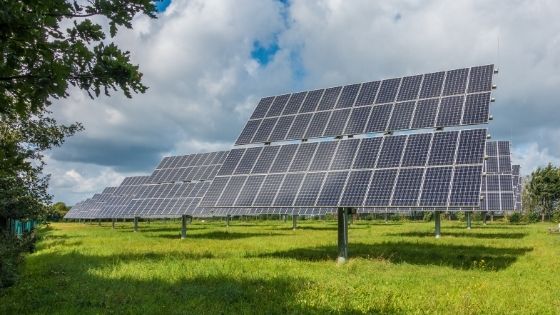Large-scale solar power facilities are rapidly being created, with plans to utilize millions of acres of land throughout the world. It is presume that energy provided by new solar power plants will supplant electricity generated by existing American generating systems.


Solar-powered electricity generation is rapidly expanding. The current installed capacity in the world is more over 22 GWp(Global-warming potential), and it is growing at a rate of 40% per year. New York is striving for a 24 percent renewable energy goal by 2013, and a 37 MWp photovoltaic installation on Long Island will be completed soon. An 80 MWp solar power facility is already operational in the Canadian province of Ontario.
Environmental impacts of large-scale solar power plants
Here we will discuss some of the positive impacts of solar panels on the environment
1- Land use intensity:
Land use intensity is an important impact frequently used as a proxy for other impacts, it has a considerable influence. Land usage for solar power is frequently characterized in terms of land per rated capacity and does not require mining for fuel. The land occupancy statistic gathers the most data and enables for the most accurate comparison of solar and coal power. Because the disturbance caused by a solar power plant is smaller than that caused by coal mining, the recovery time for the forest is estimated to be 10 years on average.
2- Human health and well-being:
Most of the effects on human health and well-being from solar energy use in forest areas are positive, such as poisonous emissions from fossil fuel burning. Traditional energy generation emits 50–1000 times more direct Hg than photovoltaics built with CdTe(Cadmium telluride). Switching to solar electricity will reduce mercury deposition in lakes and rivers, making them more useful for fishing and recreational purposes. Large-scale solar power deployment might also reduce or eliminate mountaintop mining.
3- Impacts on climate:
The reduction of carbon dioxide emissions from traditional power generation is a primary reason for solar power deployment in forests. Carbon sequestration is defined as the net removal of carbon from the atmosphere or the avoidance of carbon emissions. Solar power’s life cycle emissions of CH4 and NO2 in forests are projected to be significantly lower than those of fossil fuels.
4- Renewable energy sources:
Solar energy is a renewable energy source. This implies there is much of it to go around because it is a source of energy that will not run out. Fossil fuels are a limited source of energy that causes environmental damage when mined and distributed in such away Solar panels reduce the use of fossil fuels.
Other impacts of Solar Energy:
Solar power has the potential to provide electricity to 7 billion people in a sustainable and cost-effective manner. This is not to say that solar power is without flaws. Let us have a look at them:
Energy demand:
Mining, manufacturing, and transportation all need a great deal of energy. The production of solar energy necessitates a large quantity of energy up front. Quartz must be treated, cleaned, and then assembled with other components from a variety of sources. During the processing stage, extremely high heat is required to heat the quartz.
Hazardous chemical:
The production procedure is not completely free of contaminants. Monocrystalline solar cells generate a lot of waste silicon and consume a lot of energy. Solar-grade silicon for use in solar panels is made with toxic chemicals. Not every firm appropriately disposes of these substances or recycles their waste. Toxic compounds included in thin film solar cells can affect the environment.
Wildlife and habitat:
Clearing and using vast tracts of land for solar generating installations can have several negative consequences for native plants and wildlife, including habitat loss and interference with rainfall and drainage. When species are classed as sensitive, uncommon, or vulnerable and endangered, the consequences are amplified.
California example:
Most of the impact on animals and habitat is due to land occupation by the power plant itself. Large swaths of desert terrain in California may be barred from solar energy development, owing to animal concerns. An environmental impact analysis for the 550 MWp (megawatts peak) Topaz solar project in central California indicated that hundreds of protected animals and plants might be harmed.
Water consumption:
The cooling systems of concentrated solar thermal plants require a lot of water. Many of the places with the greatest solar efficiency potential also have the driest weather, making this a challenging barrier to overcome.
Vast Land use:
As solar farms are situated on the ground, they cannot be shared with agricultural endeavors, unlike wind farms. Solar farms can be placed in Greenfield areas or invested in floating solar panels for reservoirs to reduce their environmental effect, but they may take up more field and have an influence on the land they are on.
Conclusion:
Through the above discussion it is concluded that the Large-scale solar power plants are fast being built throughout the world. Most of the consequences of solar energy consumption are favorable, however the production process and other components are not flawless yet, but that should not deter you from making an investment.
Every solar panel purchased contributes to the advancement of research and development. We could have better, more reliable, and more effective solar energy with the aid of the public and customers.
















